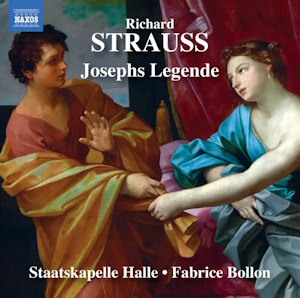
Richard Strauss (1864-1949)
Josephs Legende, op.63, TrV 231 (1912-14)
Staatskapelle Halle/Fabrice Bollon
rec. 2022, Paul-Gerhardt-Kirche, Leipzig, Germany
Naxos 8.574551 [72]
There are no two ways about it – and I speak as a Strauss devotee – whichever way you look at it, this ballet, the longest of his purely orchestral works, is second-rate Strauss which has never enjoyed the success or esteem of the composer’s major works. There are reasons behind that comparative failure: first, it was a commission from Diaghilev which was soured and frustrated by the impresario‘s break with Nijinsky and the outbreak of war soon after the 1914 Paris premiere; secondly, despite having a free hand to write for an outsize orchestra Strauss was clearly bored by the subject and although his music evinces all the usual Strauss tropes, that ennui is betrayed by its intermittent lack of inspiration; as a result, it is only sporadically engaging. The most convincing recording to date came from Giuseppe Sinopoli with the Dresden Staatskapelle made for DG in 1999 and that forms my own point of comparison (review ~ review). The Dresden orchestra is steeped in Strauss history and entirely at home with his exotic-erotic idiom but the Staatskapelle Halle easily matches it in sumptuousness and their recorded sound is if anything fuller and more detailed. However, little details work in Sinopoli’s favour, such as the execution of the downward skittering violin figure at the start, which is cleaner, clearer and sharper. There is also the question of pacing and tempi; Sinopoli is overall fully eight minutes faster than Bollon who misses some of the drive and urgency necessary in such a long and episodic piece – especially for armchair listening. Sinopoli applies more dynamic contrast, too.
Given the exoticism of the subject, there is a lot of Salome in the music, especially in the dances. Take, for example, Sulamith’s Dance (track 7), lip-smackingly subtitled “Die glühendste Liebessehnsucht” – The Most Ardent Desire – for which the timings are in fact virtually identical but Sinopoli elicits more sensuality from the music; likewise, he imparts more rhythmic spring and impact to the violent Boxers’ Dance (track 9), with much more impressive timpani, whereas Bollon’s are too muffled and recessed. Passages such as the sequence of Joseph’s dances culminating in “The Glorification of God” obviously gave the atheist Strauss some trouble and it is clear that at times he is resorting to “note-spinning”. As he remarked, “This God-seeker Joseph, he’s going to be a hell of an effort!” – yet he could still touch “spiritual” sublimity in other works, such as in his depictions of nature, like “On the summit” in Die Alpensinfonie. Here, however, there are fewer such opportunities. A central scene is when Potiphar’s wife is seized with desire for the innocent shepherd boy – “the chaste Joseph” as the libidinous Strauss mockingly labelled him – and again Sinopoli finds more drama and passionate yearning in that passage. So it goes throughout: Bollon and the Halle orchestra make a good job of music which Sinopoli and the Dresdeners play even better – but such things are relative and I suggest that no one encountering this recording without foreknowledge of the Sinopoli would be disappointed – except, perhaps, by the occasional longueur in the music itself.
Ralph Moore
Help us financially by purchasing from


















